

Technology and Law’s Future: A Twitterchat. Technology and Law’s Future: A Twitterchat. FuturesChat - Business Structures and Innovation - CBA Legal Futures Initiative. FuturesChat will continue into November every Tuesday at 7 p.m.
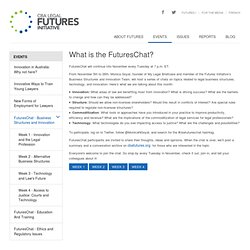
ET. From November 5th to 26th, Monica Goyal, founder of My Legal Briefcase and member of the Futures Initiative’s Business Structures and Innovation Team, will host a series of chats on topics related to legal business structures, technology, and innovation. Here’s what we are talking about this month: Law: The Future is Here. LVI 2012 Keynote Address Live Stream. Richard Susskind’s #LVI2012 Keynote: Liberating the Law Yet Further. Susskind organized his keynote around two concepts he believes will lower the cost of legal services and increase access to justice: the commoditization of legal services and the development of disruptive technologies.
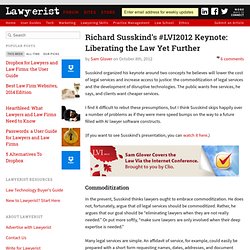
The public wants free services, he says, and clients want cheaper services. I find it difficult to rebut these presumptions, but I think Susskind skips happily over a number of problems as if they were mere speed bumps on the way to a future filled with AI lawyer software constructs. (If you want to see Susskind’s presentation, you can watch it here.) Commoditization In the present, Susskind thinks lawyers ought to embrace commoditization. Many legal services are simple. 1 key differentiator between traditional and adventurist firms. There is 1 key element to a successful modern firm, but what is it?
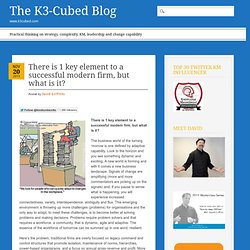
The business world of the turning ‘morrow is one defined by adaptive capability. Look to the horizon and you see something dynamic and exciting. A new world is forming and with it comes a new business landscape. Signals of change are amplifying (more and more commentators are picking up on the signals) and, if you pause to sense what is happening, you will experience increased connectedness, variety, interdependence, ambiguity and flux. This emerging environment is throwing up more challenges (problems) for organisations and the only way to adapt, to meet these challenges, is to become better at solving problems and making decisions.
LKE - a new legal career - Legal Knowledge Engineer.
Avoiding Extinction: Reimagining Legal Services for the 21st Century. Richard Susskind. Tim Hwang Isn't A Lawyer, But He Plays One Online. Tim Hwang founded faux-law firm Robot Robot & Hwang in 2010 as “a legal startup” having a single human partner.
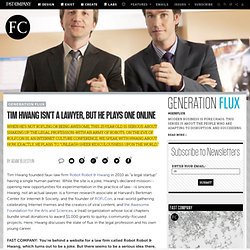
While the site is a joke, Hwang’s declared mission--opening new opportunities for experimentation in the practice of law--is sincere. Hwang, not an actual lawyer, is a former research associate at Harvard’s Berkman Center for Internet & Society, and the founder of ROFLCon, a real-world gathering celebrating Internet memes and the creators of viral content, and the Awesome Foundation for the Arts and Sciences, a (real) organization whose local chapters bundle small donations to award $1,000 grants to quirky, community-focused projects. Here, Hwang discusses the state of flux in the legal profession and his own young career. FAST COMPANY: You’re behind a website for a law firm called Robot Robot & Hwang, which turns out to be a joke. But there seems to be a serious idea there, too. Can you automate the practice of law? - MyCase Blog. (Photo credit: rkrichardson) Legal futurists spend their time studying, analyzing, and predicting the future of the legal profession.
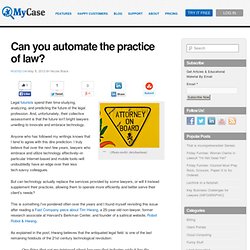
And, unfortunately, their collective assessment is that the future isn’t bright lawyers unwilling to innovate and embrace technology. Anyone who has followed my writings knows that I tend to agree with this dire prediction. I truly believe that over the next few years, lawyers who embrace and utilize technology effectively–in particular Internet-based and mobile tools–will undoubtedly have an edge over their less tech-savvy colleagues. But can technology actually replace the services provided by some lawyers, or will it instead supplement their practices, allowing them to operate more efficiently and better serve their client’s needs?
Technology and Law’s Future: A Twitterchat. The end of lawyers?: Richard Susskind’s vision of the future of legal practice. Can you imagine a world without lawyers?

When Lionel Hutz, the Simpsons’ shyster attorney on the long-running animated series contemplated this possibility, it brought a chilling apparition to his mind of people of all nationalities holding hands and dancing around in a circle under a rainbow. Legal technology guru Richard Susskind’s vision of the future of the legal profession isn’t quite so bleak. Susskind, a distinguished law professor from the U.K., has written extensively on the evolution of the legal profession and the impact of emerging technologies.
Practice Innovations Newsletter, January2012 – Thomson Reuters. The recent down economy is making knowledge management (KM) more popular than it has been for a while, due to the need for increased efficiency.
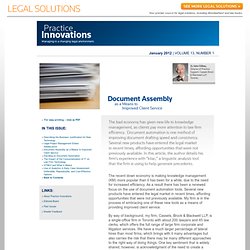
As a result there has been a renewed focus on the use of document automation tools. Several new products have entered the legal market in recent times, affording opportunities that were not previously available. My firm is in the process of embracing one of these new tools as a means of providing improved client service. By way of background, my firm, Cassels, Brock & Blackwell LLP, is a single-office firm in Toronto with about 200 lawyers and 45 law clerks, which offers the full range of large firm corporate and litigation services.
We have a much larger percentage of lateral hires than most firms, which brings with it many advantages but also carries the risk that there may be many different approaches to the right way of doing things. It is now possible to leverage computer-based content analysis to: Sources. Is bigger really better? Supersized law firms generate skepticism. We’ve all heard the saying: “Bigger isn’t always better.”

And that can often be the case. An outbreak of so-called mega-mergers of already supersized law firms is generating skepticism among senior legal officers within the Fortune 100, according to a recent Wall Street Journal report. New ALM Legal Intelligence Report: Law Firm Partnership "Ain't What it Used to Be" It is hard to believe that less that 20 years ago law firm partners followed a relatively safe and dignified trajectory from junior partner through retirement..
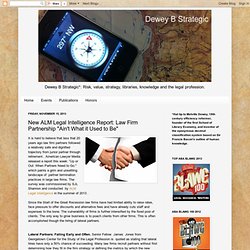
Video: Virtual Law Firm Basics and Benefits: Tools for Your Practice. A Referendum on the Partnership Model?: or Susan Responds to Ryan Responding to Susan Responding to Jordan Responding to Something Toby Said Two Days Ago. From Susan Hackett's comment on yesterday's post.

I was chatting yesterday with a great guy who's been in-house as a GC for most of his professional life, and has recently affiliated with a law firm. He loves this firm and he loves the people he works with, but his one frustration is the slow pace of decision-making/change due to the business model for operations in the firm - even in a firm that is as progressive as the one he's joined up with. Designing Lawyers. This post originally appeared on the LexisNexis UK Future of Law Blog under the title Stealing the market: The degree that now has infinite value. On 17 October I saw Daniel B. Susan Responds to Jordan's Response of Toby's Critique of Jordan. Jordan and I will need to add Susan Hackett to our traveling road show as she has now entered the fray.
Below Susan responds to Jordan's critique of my critique of his original post. (Just writing that makes me kind of dizzy).See if you can follow the bouncing ball in this interesting debate.Thanks to Susan for adding to the conversation.I'm with you both on many of the points raised, but have to say I'm most interested in two elements here that Jordan addresses near the end of his post and that he's promised to cover at Law21: 1.) the issue of training (or should I say "lack of training") in most firms because partners are so busy performing as much work as they can themselves (and sometimes hoarding hours and clients that should be served by others who are more junior) that they take no time to invest in the next generations of lawyers who will succeed them in the firm at EVERY level. and Maybe GT will fail.
Sounds of the Echo Chamber. My posts have subsided a bit lately as I felt an echo chamber growing and started questioning a lot of stuff I was reading as either echoes or reiterations of prior statements. Some of these echoes are new angles on old subjects, but they merely restate the basic premise: BigLaw is broken and doomed.
I feel lately, the echos are drowning out critical thinking. And now I shall unfairly pick on my good friend Jordan Furlong. The decline of the associate and the rise of the law firm employee - Law21. Earlier this month, Greenberg Traurig became the latest large US firm to take a new approach to its legal talent. Rather than firing secretaries or de-equitizing partners, however, as is all the rage elsewhere, Greenberg proposed something different and potentially groundbreaking: the introduction of a “residency” program for new associates. Here’s how the Am Law Daily describes it: Join the firm as an associate, but only if you’re willing to spend a third of your time training rather than churning out billable work.